Resistance bands may look simple to use, but there are a few important nuances you should be aware of if you’re to gain the full benefits at home. This post explains how to use resistance bands at home, PROPERLY!
Resistance bands can be used at home just like any other equipment. It is important to choose bands with a suitable tension level and a secure anchoring attachment. It is also recommended to structure an effective home workout program that targets all the major muscle groups in the body.
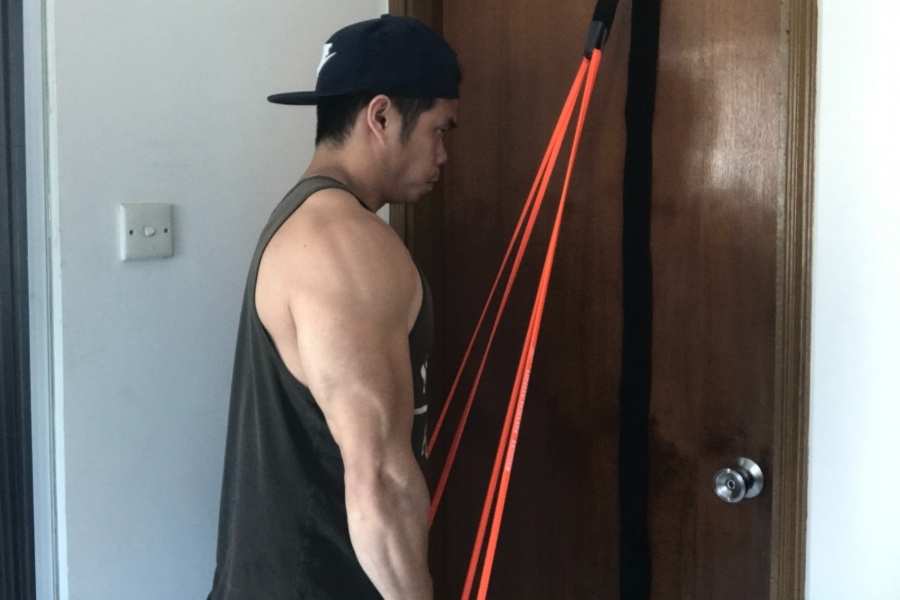
I’ve been using resistance bands at home for 5 years now (whenever I can’t get to the gym).
They’ve helped me to build muscle, lose fat, and get toned.
Below, I share 10 steps on how you can do the same.
Keep reading to the end for a full-body band workout you can try at home!
1) Decide Which Resistance Bands To Use At Home
Home resistance bands come in loop and tube varieties. Both work similarly and can be used for a variety of exercises that target all of the major muscles in the body. Loop bands are generally more durable and better than tube bands, which are prone to snapping.
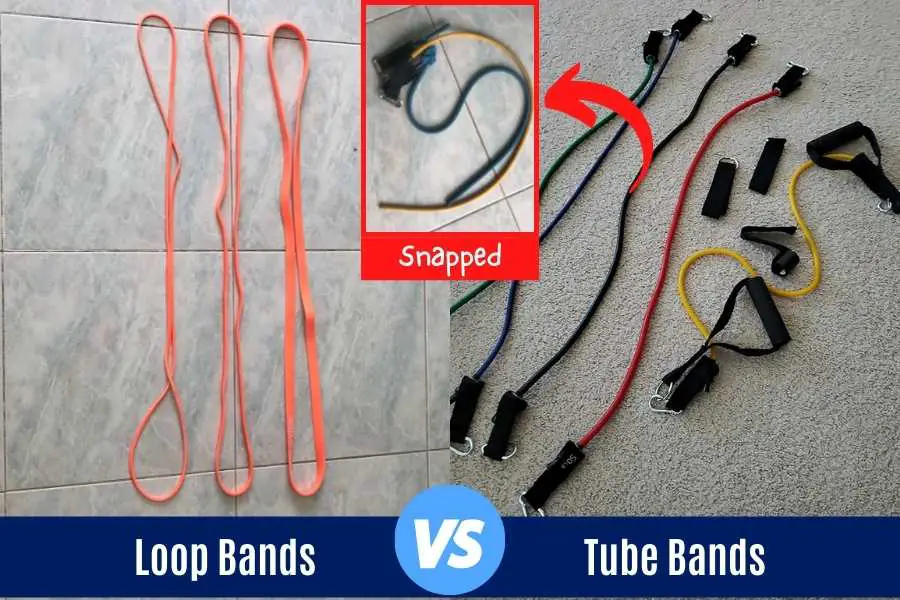
I’ve had numerous sets of tube-shaped resistance bands (the ones with the handles) snap on me in the past.
This is why I always recommend loop bands over tube bands.
Resistance bands also come in a variety of resistance levels from extra light to medium to extra heavy.
The most convenient way to buy bands is to get them as a set.
This way, you have access to a variety of tension levels that are suitable for different muscle groups (large and small) without the headache of picking individual bands.
A set also gives you much greater room for future progression.
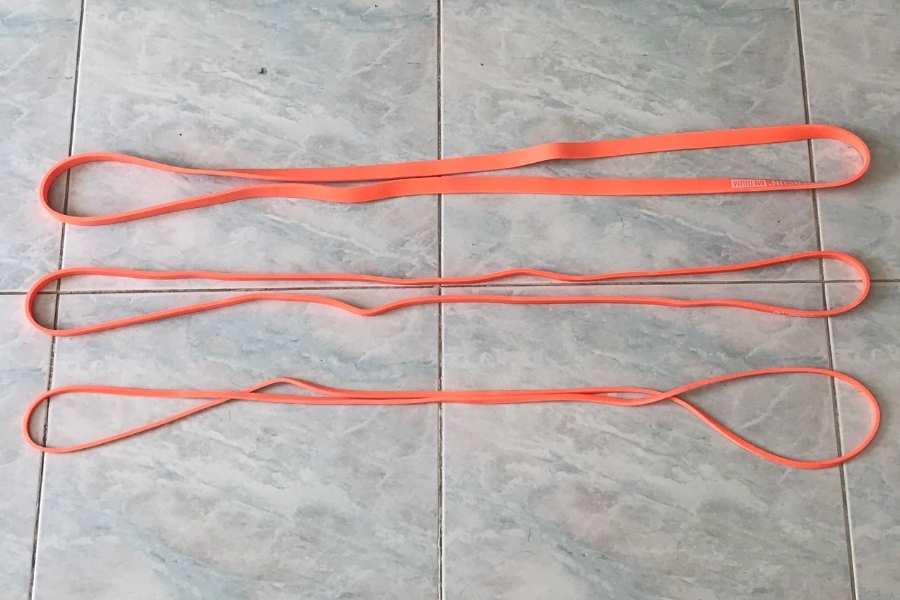
I’ve been using the Undersun bands for 3 years now and couldn’t recommend them more.
I like them because they’re an affordable set, versatile, and provide most people with enough resistance to last them for years of progression!
2) Choose A Home Resistance Band Workout Goal
Resistance bands can be used to build muscle, increase power and strength, tone, lose weight, and get ripped at home. Different training goals dictate how an individual should use their resistance bands, as well as what exercises to perform, to reach their goal.
Here’s an overview of how to use resistance bands to achieve some of the most common training goals:
| Training Goal | Recommended Resistance Level | How To Use Resistance Bands At Home | Recommended Nutrition |
|---|---|---|---|
| Build muscle | Moderate to heavy. | 8-15 reps per set, 1-2 minute rest between sets, compound and isolation movements. | Calorie surplus and high protein. |
| Increase power and strength | Heavy to extra heavy. | 5-8 explosive reps per set, 3-minute rest between sets, compound movements | Calorie surplus and high protein. |
| Body toning | Light to heavy. | 8-15 reps per set, 30-60 second rest between sets, compound and isolation movements. | Calorie deficit and high protein. |
| Burn fat | Extra light to moderate. | 15-25 reps per set, 30-second rest between sets, compound movements. | Calorie deficit and high protein. |
| Get ripped and shredded | Moderate to extra heavy. | 8-15 reps per set, 30-60 second rest between sets, compound and isolation movements. | Calorie deficit and high protein. |
These are just general guidelines for the kinds of results you can expect to achieve (link to see Reddit examples) from home resistance band workouts.
In reality, you’ll likely achieve multiple results simultaneously without even realizing it.
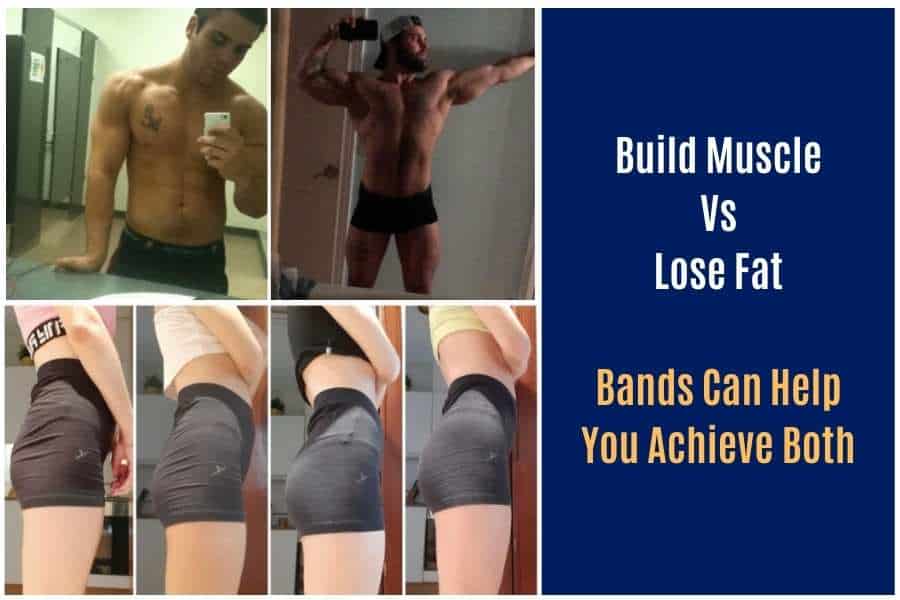
For example, muscle gains usually come hand in hand with strength increase, power development, and an overall more toned body.
Likewise, fat loss usually comes with a more ripped and shredded appearance.
But choosing a single goal gives you a clear objective to focus on as a beginner, and this will increase the chances of success from your home resistance band workouts.
3) Select Resistance Band Home Workout Exercises
A resistance band can be used to target the whole body using a variety of compound-type and isolation-type exercises. Combined, these are effective for emphasizing individual muscles as well as larger muscle groups. Different exercises will target different muscles more effectively than others.
Here are some of the best home resistance band exercises to emphasize different muscles and body parts:
| Body Part To Emphasize | Muscles To Work | Compound Band Exercises | Isolation Band Exercises |
|---|---|---|---|
| Chest | Pectoralis major and minor. | Flat/incline/decline band press. | Banded chest flyes. |
| Shoulders | Anterior/posterior/lateral deltoids. | Overhead band press. | Lateral raise with bands. |
| Arms | Biceps and triceps. | Rows and presses. | Banded arm curls and extensions. |
| Back | Trapezius, rhomboids, and latissimus dorsi. | Row with bands. | Reverse band flyes. |
| Abs | Abdominals and obliques. | All compound band movements work core. | Banded ab crunches and core rotations. |
| Legs and bum | Quadriceps, hamstrings, calves, and gluteus maximus. | Squats and deadlifts with bands. | Ham curls, leg extensions, and kickbacks. |
You may be wondering what the difference is between a compound and isolation-type movement.
So here it is:
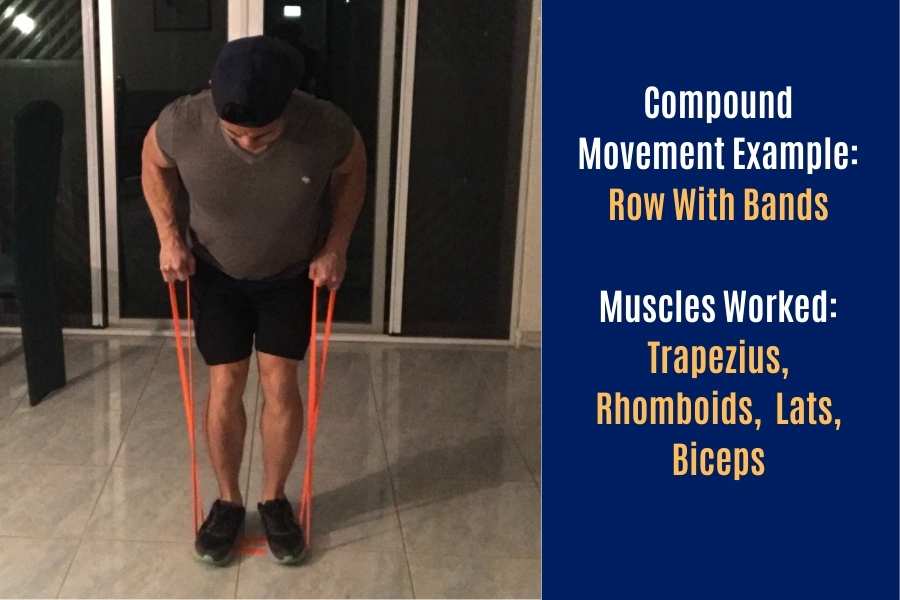
- Compound band movements- target multiple muscles at once. For example, the banded row will engage your back muscles primarily but also work your arms, and core to stabilize the movement. These exercises give you the biggest bang for your buck.
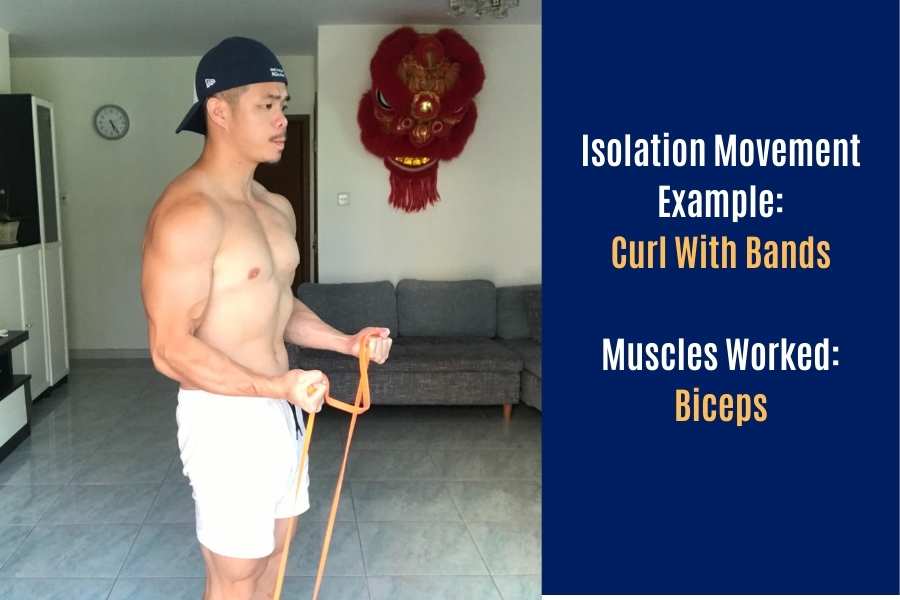
- Isolation band movements- target specific muscles. For example, the banded curl mainly works your biceps. These exercises are ideal for defining and toning specific muscles or body parts like the arms. But they are generally not good for maximizing a calorie burn or building max muscle.
4) Determine How Many Times A Week To Use Resistance Bands
Resistance band workouts should generally be performed 3-4 times a week with at least 24 hours of rest between workouts for best results. Beginners may choose to train less whilst experienced individuals may choose to train more. Each workout should take 15 to 60 minutes.
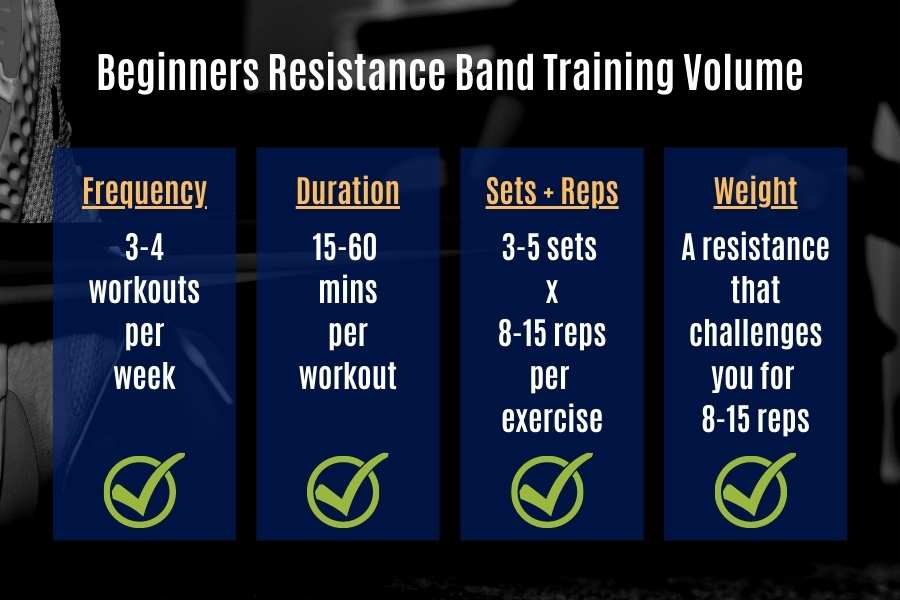
If you’ve never worked out before, then stay on the lower end of the spectrum.
3 training days per week, with each workout lasting 30 minutes of intense activity, is more than enough for a beginner to see results (assuming you challenge yourself on each workout).
Do this for a couple of months and you should feel you’re body adapting to your home resistance band workouts (exercises become easier to perform).
At this point, you can apply progressive overload by increasing the frequency of training, workout duration, or resistance band weight.
By progressing in this way, you’ll give yourself the time required to learn how to properly use your resistance bands at home without the risk of overtraining (i.e. denying your muscles the time it needs to recover), as well as keep yourself sufficiently challenged as you become fitter.
5) Establish Of Sets And Reps For Each Band Exercise
3-5 sets of 8-15 repetitions per exercise are generally sufficient to see results with resistance band workouts at home. But it is essential to use enough resistance such that the exercise is challenging. Beginners should start with a low set and rep count, and increase this as they become fitter.
Just to be clear on what constitutes a set and a rep:
- Set. This is completed by doing consecutive repetitions of the same exercise without taking a break. Beginners should start with 3 sets per exercise per workout, and progress into 5 sets (no more than this).
- Rep. Short for repetition. This is completed after you’ve performed an exercise once. In a resistance band bicep curl example, lowering the band and then curling it back up would count as a single rep. You should generally aim for 8-15 reps per exercise per workout for most fitness goals, but up to 25 reps per set (using a lighter weight) can be beneficial for fat loss goals.
You risk overtraining if you do any more than these recommendations.
Likewise, you also risk not challenging yourself enough if you do less than these recommendations.
You can stick to my advice when you start using your resistance bands at home, and you’ll be in the sweet spot for results!
6) Choose A Suitable Weight For Workouts
Resistance bands come in a variety of tension levels, and different manufacturers use different ways to identify which bands are what weight.
Color-coding is a popular way to differentiate between bands of different resistance levels. These resistance bands are assigned a color depending on weight.
Other brands such as Undersun use non-color-coding, where each band is simply labeled “extra light”, “light”, “medium”, and so on.
Regardless of which coding method is being used, you must choose the right weight if you want the best training results.

How do you know you’ve got the ideal resistance band tension?
The band should challenge you towards the last few reps of however many reps you’re performing.
So if you’re aiming to complete 8 reps per set, then you’re target muscle should feel fatigued by the 6th-8th rep.
If your muscle isn’t feeling fatigued– then you know to increase the weight (select a heavier band).
If you’re struggling to lift the band even on the starting reps, then you know to decrease the weight (select a lighter band).
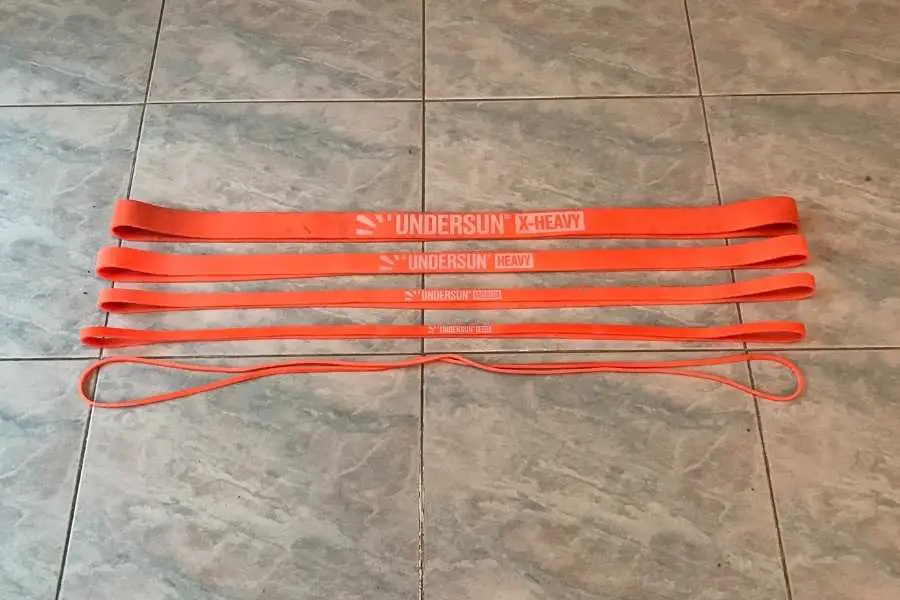
The Undersun bands I use and recommend come as a set of 5 bands that have a variety of resistance levels to effectively challenge any muscle group at most fitness levels.
This means you can experiment to find the ideal tension for your abilities!
7) Pick A Suitable Spot For Resistance Band Home Workouts
Resistance bands can be used in most locations with more than 2 square feet of space. Popular areas to work out with resistance bands include; at home, at the park, beach, and in the garden. Bands can even be used in bed to perform small exercises like a pull-apart.
Yup, you read that right, you can use resistance bands in bed or on the sofa!
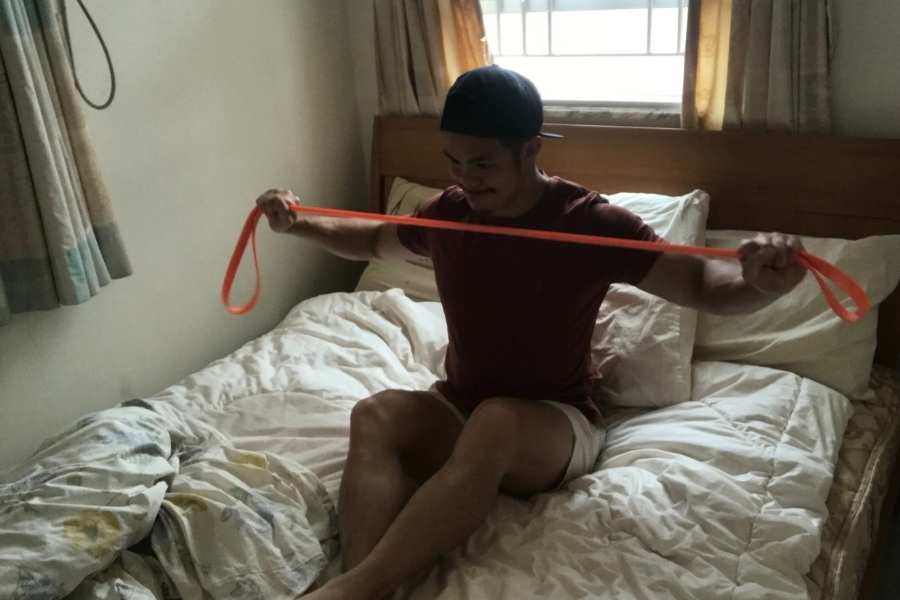
In most instances, however, I would recommend using any floor space larger than 2 square feet.
This will give you enough room to perform exercises most effectively.
Even if you live in a small home, resistance bands can be used for an effective workout by finding a small area of floor space in the living room, kitchen, etc.
Ideally, the workout space should also be clutter-free.
You don’t want to knock over any furniture or hit yourself against an object!
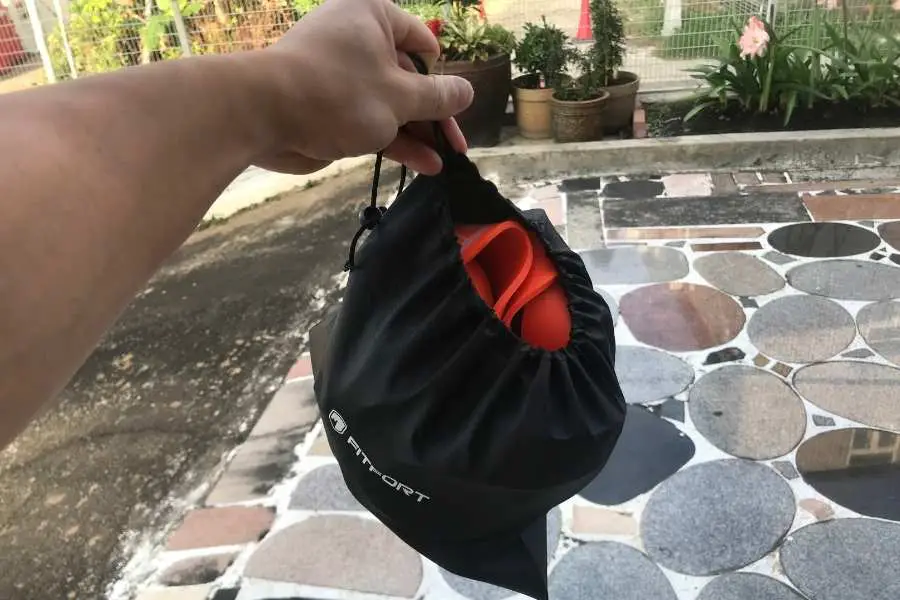
The Undersun bands come with a handy travel bag that means you can conveniently take them anywhere for a quick workout!
8) Secure Your Resistance Bands To A Home Anchor
Resistance bands can be secured at home using the body or separate attachments. Body securement requires the user to step on the band or loop it around the torso and limbs. Attachment securement requires the band to be looped around a door anchor or pull-up bar.
Attaching your bands to a secure anchor is ESSENTIAL.
Trust me, you don’t want a band snapping back onto you due to a weak anchor. Not only does it hurt (a lot!), but it can also damage your property.

Body anchoring is cheap and effective. But it limits the range and angles that can be achieved with your bands.
I prefer to use door anchors like the Boss anchor. They’re cheap, convenient to use, open up new angles, and make your exercises much safer to perform.
The Undersun bands recommended throughout this post come with a bundled anchor so you won’t need to buy one separately.
You can also attach bands around a horizontal bar and your butt to do assisted pull-ups. But you’ll need to be careful about selecting the right size bands for pull-ups.
9) Start Lifting Your Resistance Bands
Resistance bands should be lifted just like free weights for the most part. However, bands also come with certain nuances. Since they generate the greatest tension when fully stretched, lifting with a full range of motion is important for getting the maximum benefits from band exercises.
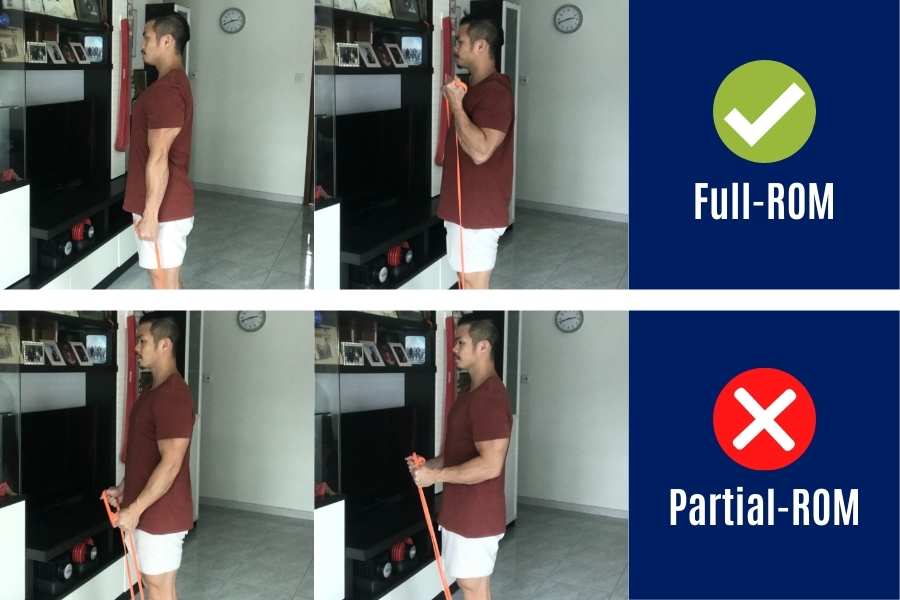
Lifting with a full range of motion (ROM) simply means moving your joint from the furthest point of extension to the furthest point of flexion.
In a bicep curl example, a full ROM means your forearm should become almost parallel to the upper arm at the end of the downward phase, and your hands almost touch the shoulders at the end of the upward phase.
By lifting with a full ROM, your biceps will become maximally activated at the top of the curl where the resistance band is at its greatest stretch.
And this is important for getting the most from your home resistance band exercises
Therefore, the ROM principle should be applied to all your exercises.
For more information, you can check out my other post on how resistance bands actually work.
10) Take A Short Rest In Between Sets
A typical resistance band workout can be as short as 15 minutes or as long as 60 minutes. This includes all of the rest time in between sets. It is recommended to rest between 30 seconds to 3 minutes between sets, depending on the training goal trying to be achieved.

If you’re trying to burn fat, then take shorter breaks in between sets (30-60 seconds).
You want to keep your heart rate elevated for as long as possible. And this is best achieved by keeping your muscles working as long as possible.
If you’re trying to build muscle and strength, then take longer breaks (2-3 minutes).
You want to allow enough time for your muscles to recover before exerting your maximum effort on the next set again.
And if you’re looking to achieve a combination of both goals, then go for a duration in between (1-2 minutes).
Set a timer on your phone or use a fitness watch.
Once you’ve rested, you can complete the next set!
Unsure if resistance bands are right for you? You can check out my other article which explains if resistance bands are worth it!
Example Full-Body Resistance Band Home Workout
Considering all 10 steps, here’s a simple 3-day full-body workout you can do with resistance bands at home.
Overview:
You’ll use your resistance bands to work your entire body at home 3 days a week, with at least 24-48 hours of rest between workouts. This will give your body enough training stimulation to be beneficial, as well as the time it needs to recover before the next workout.
Monday:
| Resistance Band Exercise | Sets | Reps | Rest |
|---|---|---|---|
| Flat band press | 3 | 8 | 1-3 mins |
| Resistance band row | 3 | 8 | 1-3 mins |
| Overhead band press | 3 | 8 | 1-3 mins |
| Resistance band crunch | 3 | 12 | 1-3 mins |
| Bicep curl with bands | 3 | 12 | 1-3 mins |
| Band squats | 3 | 10 | 1-3 mins |
Wednesday:
| Resistance Band Exercise | Sets | Reps | Rest |
|---|---|---|---|
| Incline band press | 3 | 8 | 1-3 mins |
| Resistance band row | 3 | 8 | 1-3 mins |
| Resistance band lateral raise | 3 | 12 | 1-3 mins |
| Banded core twist | 3 | 12 | 1-3 mins |
| Tricep extension with bands. | 3 | 12 | 1-3 mins |
| Deadlift with bands | 3 | 8 | 1-3 mins |
Friday:
| Resistance Band Exercise | Sets | Reps | Rest |
|---|---|---|---|
| Chest fly with bands | 3 | 12 | 1-3 mins |
| Reverse fly with bands | 3 | 12 | 1-3 mins |
| Overhead band press | 3 | 8 | 1-3 mins |
| Resistance band crunch | 3 | 12 | 1-3 mins |
| Bicep curl with bands | 3 | 12 | 1-3 mins |
| Band squats | 3 | 10 | 1-3 mins |
Progression:
Start by using a weight that challenges you for the reps specified on each exercise.
As you get stronger, the exercises should become easier to perform.
When you’re ready, you can increase the intensity by:
- Increasing reps. Avoid rep ranges over 15 per set if your goal is to build muscle.
- Increasing sets. Avoid more than 5 per exercise per workout (excessive).
- Increasing weight. Move up to the next band tension. Or combine multiple bands.
- Reducing rest times. This is a good way to burn more fat!
- Including more exercises. Hundreds of different movements can be found online.
Recommended Resistance Bands For Home Workouts:
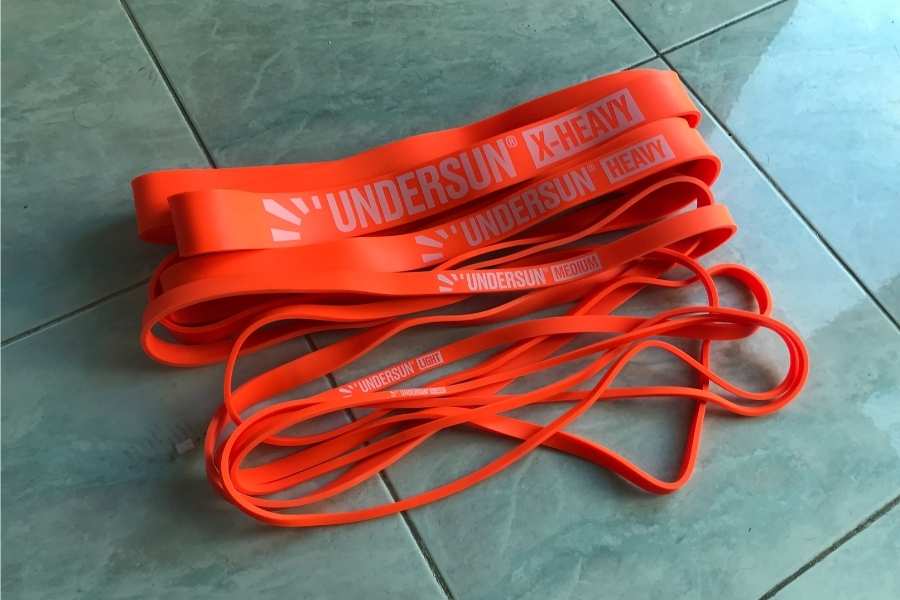
I use and recommend these Undersun bands.
They come as a set of 5 different bands with varying degrees of tension. They can be used to effectively hit each muscle (large and small) for people at all training levels (beginners to advanced).
My favorite thing about them is their durability and lifetime warranty.
Having cycled through multiple sets of budget Amazon bands in the past, I always recommend spending the extra 30 or so bucks for something that will last you forever!
Conclusion
I’ve shared 10 steps to start using resistance bands at home.
I’ve also given you an example full-body workout based on the 10 steps shared.
When used properly, bands are one of the most convenient, safest, and easiest types of resistance training equipment for an effective home workout.
And this article has shown you exactly how to use them!
What other ways will you be using your resistance bands at home?
Feel free to send me a message if you have any questions! You can find my details on the “contact us” page.
You may also be interested in the downloadable Kalibre Blueprint PDF which details exactly how I gained 40lbs of lean muscle (it’s 100% free!). It details the exact exercises and nutrition (with printable worksheets) I used to go from skinny to ripped!
Thanks for reading guys!
Peace Out,
Kal
(Biochemistry BSc, Biomedical Sciences MSc, Ex-Skinny Guy)


